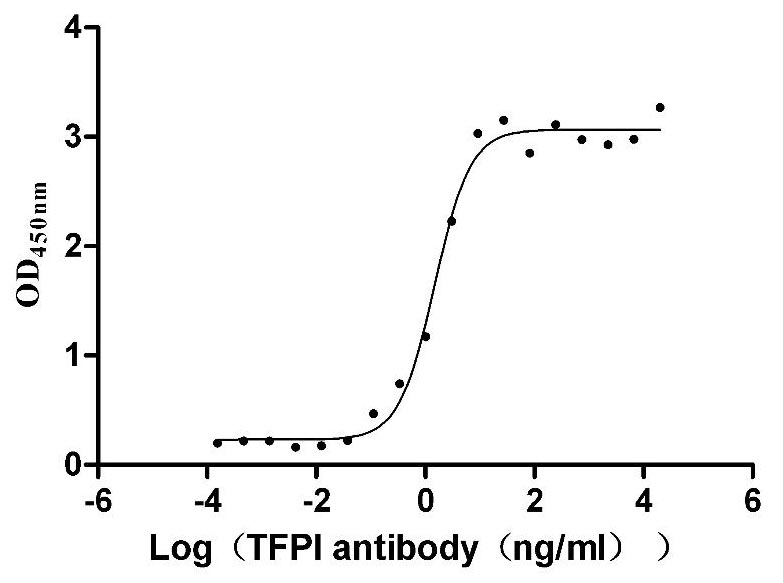Recombinant Escherichia coli mRNA interferase RelE (relE)
-
中文名稱(chēng):大腸桿菌relE重組蛋白
-
貨號(hào):CSB-YP313354ENV
-
規(guī)格:
-
來(lái)源:Yeast
-
其他:
-
中文名稱(chēng):大腸桿菌relE重組蛋白
-
貨號(hào):CSB-EP313354ENV
-
規(guī)格:
-
來(lái)源:E.coli
-
其他:
-
中文名稱(chēng):大腸桿菌relE重組蛋白
-
貨號(hào):CSB-EP313354ENV-B
-
規(guī)格:
-
來(lái)源:E.coli
-
共軛:Avi-tag Biotinylated
E. coli biotin ligase (BirA) is highly specific in covalently attaching biotin to the 15 amino acid AviTag peptide. This recombinant protein was biotinylated in vivo by AviTag-BirA technology, which method is BriA catalyzes amide linkage between the biotin and the specific lysine of the AviTag.
-
其他:
-
中文名稱(chēng):大腸桿菌relE重組蛋白
-
貨號(hào):CSB-BP313354ENV
-
規(guī)格:
-
來(lái)源:Baculovirus
-
其他:
-
中文名稱(chēng):大腸桿菌relE重組蛋白
-
貨號(hào):CSB-MP313354ENV
-
規(guī)格:
-
來(lái)源:Mammalian cell
-
其他:
產(chǎn)品詳情
-
純度:>85% (SDS-PAGE)
-
基因名:relE
-
Uniprot No.:
-
別名:relE; b1563; JW1555; mRNA interferase toxin RelE; EC 3.1.-.-; Endoribonuclease RelE; Toxin RelE
-
種屬:Escherichia coli (strain K12)
-
蛋白長(zhǎng)度:full length protein
-
表達(dá)區(qū)域:1-95
-
氨基酸序列MAYFLDFDER ALKEWRKLGS TVREQLKKKL VEVLESPRIE ANKLRGMPDC YKIKLRSSGY RLVYQVIDEK VVVFVISVGK RERSEVYSEA VKRIL
-
蛋白標(biāo)簽:Tag?type?will?be?determined?during?the?manufacturing?process.
The tag type will be determined during production process. If you have specified tag type, please tell us and we will develop the specified tag preferentially. -
產(chǎn)品提供形式:Lyophilized powder
Note: We will preferentially ship the format that we have in stock, however, if you have any special requirement for the format, please remark your requirement when placing the order, we will prepare according to your demand. -
復(fù)溶:We recommend that this vial be briefly centrifuged prior to opening to bring the contents to the bottom. Please reconstitute protein in deionized sterile water to a concentration of 0.1-1.0 mg/mL.We recommend to add 5-50% of glycerol (final concentration) and aliquot for long-term storage at -20℃/-80℃. Our default final concentration of glycerol is 50%. Customers could use it as reference.
-
儲(chǔ)存條件:Store at -20°C/-80°C upon receipt, aliquoting is necessary for mutiple use. Avoid repeated freeze-thaw cycles.
-
保質(zhì)期:The shelf life is related to many factors, storage state, buffer ingredients, storage temperature and the stability of the protein itself.
Generally, the shelf life of liquid form is 6 months at -20°C/-80°C. The shelf life of lyophilized form is 12 months at -20°C/-80°C. -
貨期:Delivery time may differ from different purchasing way or location, please kindly consult your local distributors for specific delivery time.Note: All of our proteins are default shipped with normal blue ice packs, if you request to ship with dry ice, please communicate with us in advance and extra fees will be charged.
-
注意事項(xiàng):Repeated freezing and thawing is not recommended. Store working aliquots at 4°C for up to one week.
-
Datasheet :Please contact us to get it.
靶點(diǎn)詳情
-
功能:Toxic component of a type II toxin-antitoxin (TA) system. A sequence-specific, ribosome-dependent mRNA endoribonuclease that inhibits translation during amino acid starvation (the stringent response). In vitro acts by cleaving mRNA with high codon specificity in the ribosomal A site between positions 2 and 3. The stop codon UAG is cleaved at a fast rate while UAA and UGA are cleaved with intermediate and slow rates. In vitro mRNA cleavage can also occur in the ribosomal E site after peptide release from peptidyl-tRNA in the P site as well as on free 30S subunits. In vivo cuts frequently in the first 100 codons, most frequently after the second and third base and rarely near the stop codon. Overexpression of RelE results in the inhibition of bacterial growth and a sharp decrease in colony-forming ability which is neutralized by the labile cognate antitoxin RelB. Overexpression also sharply increases persisters (cells that neither grow nor die in the presence of bactericidal agents and are largely responsible for high levels of biofilm tolerance to antimicrobials). Plays a role in dormancy when expressed in high-density cells in the absence of antitoxin RelB; amino acid starvation and an unidentified extracellular factor promote dormancy, while expression of antitoxin RelB restores cell culturability. Acts with RelB as a corepressor of relBE transcription, considerably increasing the repression of RelB alone. 2 RelB dimers bind to 2 operator sequences; DNA-binding and repression is stronger when complexed with toxin/corepressor RelE by conditional cooperativity.; Seems to be a principal mediator of cell death in liquid media. Implicated in hydroxy radical-mediated cell death induced by hydroxyurea treatment.; Cross-talk can occur between different TA systems. Ectopic expression of this toxin induces transcription of 7 tested TA systems (dinJ/yafQ, hicAB, mazEF, mqsRA, prlF(sohA)/yhaV, relBEF and yefM/yoeB) with specific cleavage of the relBEF mRNA produced immediately upstream and within the relB coding sequence. The cleaved mRNA can be translated into RelE, leading to a positive feedback cycle of RelE expression. The relBEF operon is required for transcription of the mazEF TA system operon during amino acid starvation.
-
蛋白家族:RelE toxin family
-
數(shù)據(jù)庫(kù)鏈接:
KEGG: ecj:JW1555
STRING: 316385.ECDH10B_1695
Most popular with customers
-
Recombinant Rabbit Tissue factor pathway inhibitor (TFPI) (Active)
Express system: Mammalian cell
Species: Oryctolagus cuniculus (Rabbit)
-
Recombinant Human Tissue factor pathway inhibitor (TFPI), partial (Active)
Express system: Mammalian cell
Species: Homo sapiens (Human)
-
Recombinant Human Claudin-9 (CLDN9)-VLPs (Active)
Express system: Mammalian cell
Species: Homo sapiens (Human)
-
Recombinant Macaca fascicularis CD93 molecule (CD93), partial (Active)
Express system: Mammalian cell
Species: Macaca fascicularis (Crab-eating macaque) (Cynomolgus monkey)
-
Recombinant Human Mucin-17 (MUC17), partial (Active)
Express system: Mammalian cell
Species: Homo sapiens (Human)
-
Recombinant Human Trophoblast glycoprotein (TPBG), partial (Active)
Express system: Mammalian cell
Species: Homo sapiens (Human)
-
Recombinant Human Glucagon-like peptide 1 receptor (GLP1R), partial (Active)
Express system: Mammalian cell
Species: Homo sapiens (Human)
-
Recombinant Macaca fascicularis Gastric inhibitory polypeptide receptor (GIPR), partial (Active)
Express system: yeast
Species: Macaca fascicularis (Crab-eating macaque) (Cynomolgus monkey)


















